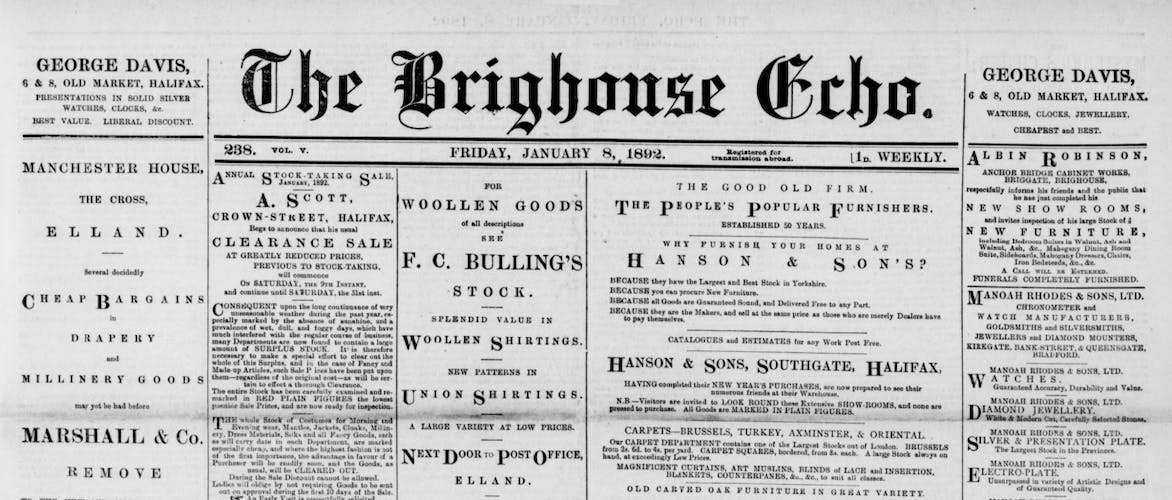The following announcement was written by the folks at Findmypast:
We're honouring Irish history this St Patrick's Day weekend. If you've got roots in the Emerald Isle, you may find a familiar name or two amongst this week's 992,000 new records.
Explore three new 18th-century sets - Protestant Householders, Dissenters' Petitions and the 1766 Religious Census - as well as new Belfast and Ulster Directory records and over 174,000 historical newspaper pages.
This week's new additions offer an unparralelled glimpse into 18th-century Irish history. From Antrim to Armagh, read on for a full rundown all that's been added this Findmypast Friday.
This week's biggest new set consists of 20,505 transcriptions from the 1766 Religious Census. Although the original documents were lost when Ireland's Public Records Office was destroyed in 1922, these extensive transcripts were recorded by antiquarian and genealogist Tenison Groves prior to the fire.
From these records, you may be able to learn the name of the head of the household, the year, their religion, the parish and the county. The information recorded varies widely, because different enumerators recorded different details.
Secondly, we've also added transcriptions of a census that was taken of Protestant householders in 1740. The 15,957 records within this new set are from parishes in the counties of Antrim, Armagh, Derry, Donegal, Down and Tyrone.

Map of Ireland, c.1716.
Also created by Tenison Groves, these transcriptions contain details like a name, year, barony, parish and county.
This week's third and final new set is a collection of historic petition records. It contains approximately 4,000 names, of people who protested the Church of Ireland's sacramental tests in 1775. The petitions consist of dissenters' names categorized by parish, congregation, town, neighbourhood, or, in one case, barony.
Occasionally, members of the Established Church also signed the petitions. The lists typically specify whether signatories were dissenters or Established Church members. In cases where no denomination is indicated, the list contained names of both dissenters and Established Church members without differentiation.
While available for all Northern Ireland counties except Fermanagh, these records are most extensive for areas in Counties Antrim and Down.
In addition to the three brand new Irish record sets, we've also made a significant update to an existing Irish collection. We added 951,127 Belfast and Ulster directory records, with both transcriptions and original images available for you to explore.
These new additions span 1831 to 1900, and contain over 900,000 names. With almost 70 years of history covered, they offer a detailed glimpse into what the North of Ireland was like in the 19th century.
We added a brand new publication - the Brighouse Echo - to our newspaper archive this week.

The Brighouse Echo, 8 January 1892.
We've also updated 57 of our existing titles, with a grand total of 174,403 new historical pages added.
Here's a full rundown of all that's been added to the newspaper archive this Findmypast Friday.
New title:
Updated titles:
- Alloa Journal, 1917
- Banffshire Advertiser, 1917
- Banffshire Herald, 1917
- Barrhead News, 1917
- Biggleswade Chronicle, 1891-1895, 1959-1966
- Brechin Advertiser, 1962-1965, 1967-1969, 1971-1972
- Bromsgrove & Droitwich Messenger, 1916-1917
- Buchan Observer and East Aberdeenshire Advertiser, 1919-1929
- Coalville Times, 1917
- Cumberland & Westmorland Herald, 1917
- Deal, Walmer & Sandwich Mercury, 1990
- Denbighshire Free Press, 1917
- Dominica Chronicle, 1917
- Durham County Advertiser, 1917
- Eastbourne Gazette, 1986
- Essex Weekly News, 1917
- Evening Irish Times, 1917
- Fraserburgh Herald and Northern Counties’ Advertiser, 1990
- Hants and Sussex News, 1917
- Hemel Hempstead Gazette and West Herts Advertiser, 1984, 1988
- Herts Advertiser, 1917
- Hornsey & Finsbury Park Journal, 1917
- Huntly Express, 1917
- Irish Weekly and Ulster Examiner, 1964
- Kent Evening Post, 1973, 1990, 1994, 1998
- Kentish Express, 1990-1991, 1994, 1998-1999
- Kentish Gazette, 1990-1991, 1994, 1997, 1999
- Leighton Buzzard Observer and Linslade Gazette, 1905-1908, 1910-1918
- Linlithgowshire Gazette, 1919-1920
- Lowestoft Journal, 1917
- Maidstone Telegraph, 1975, 1978, 1993, 1995-1996, 1998
- Mearns Leader, 1990
- Midland Tribune, 1917
- Montrose Standard, 1964
- Morecambe Visitor, 1975
- Nelson Leader, 1986
- Northern Chronicle and General Advertiser for the North of Scotland, 1917
- Port-Glasgow Express, 1964
- Retford, Worksop, Isle of Axholme and Gainsborough News, 1980
- Richmond and Twickenham Times, 1917
- Ripon Gazette, 1983-1985
- Rugby Advertiser, 1850-1852, 1982, 1986-1987
- Sheerness Times Guardian, 1990, 1999
- Shetland Times, 1948, 1950
- South Notts Echo, 1964
- Southend Standard and Essex Weekly Advertiser, 1917
- St. Andrews Citizen, 1957-1968
- Sydenham, Forest Hill & Penge Gazette, 1964
- Todmorden & District News, 1936-1951, 1980-1984
- Tonbridge Free Press, 1964
- Voice of St. Lucia, 1917
- Volunteer Service Gazette and Military Dispatch, 1917
- Wimbledon News, 1917
- Windsor and Eton Express, 1917
- Wolverton Express, 1964
- Woodford and District Advertiser, 1917
- Woodford Times, 1917
Last week we added a brand new collection of Women's Land Army records, in addition to a new Irish set and some updated Northamptonshire Militia records. Don't miss out - explore the full release for yourself.
 Latest News Articles
Latest News Articles Do you have an RSS newsreader? You may prefer to use this newsletter's RSS feed at:
Do you have an RSS newsreader? You may prefer to use this newsletter's RSS feed at: